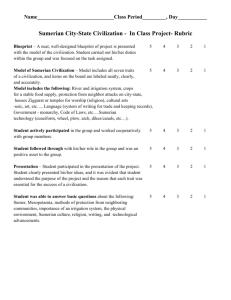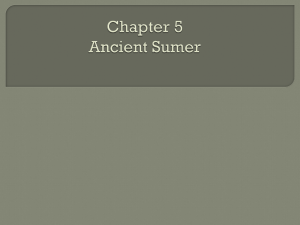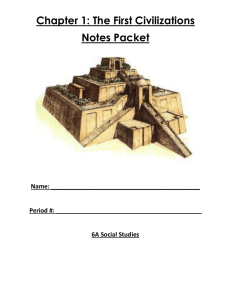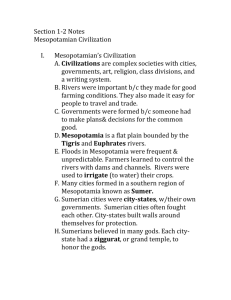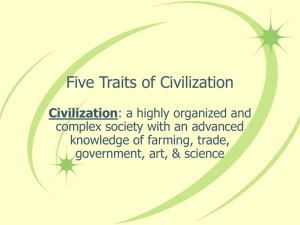History of Western Civilization I Introduction
advertisement
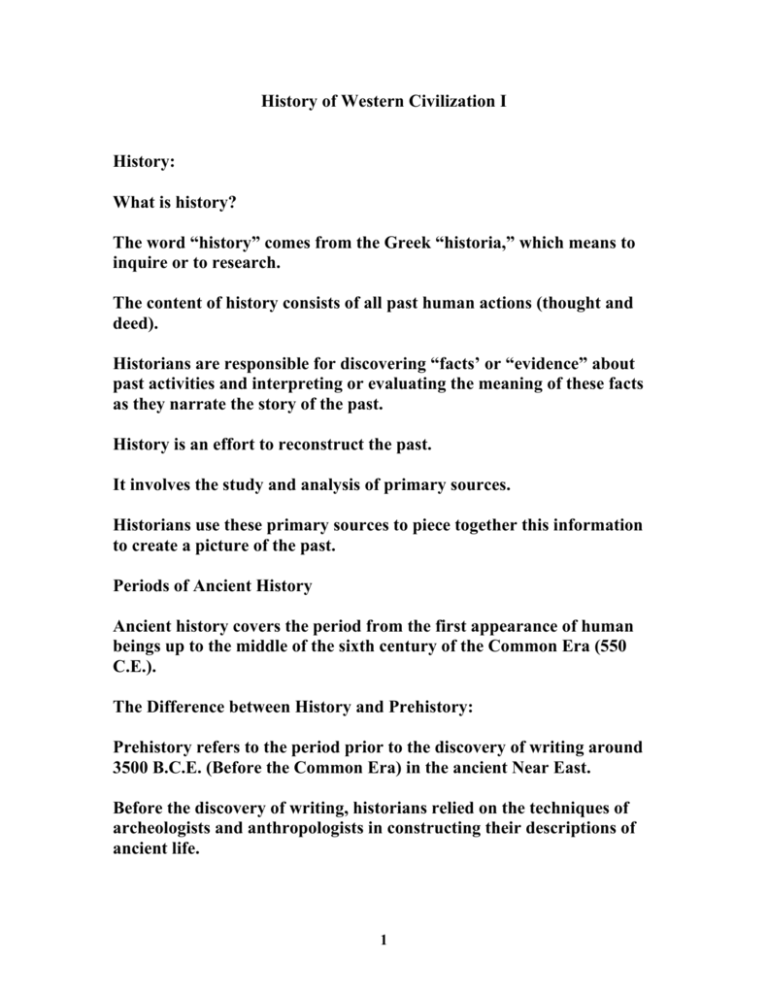
History of Western Civilization I History: What is history? The word “history” comes from the Greek “historia,” which means to inquire or to research. The content of history consists of all past human actions (thought and deed). Historians are responsible for discovering “facts’ or “evidence” about past activities and interpreting or evaluating the meaning of these facts as they narrate the story of the past. History is an effort to reconstruct the past. It involves the study and analysis of primary sources. Historians use these primary sources to piece together this information to create a picture of the past. Periods of Ancient History Ancient history covers the period from the first appearance of human beings up to the middle of the sixth century of the Common Era (550 C.E.). The Difference between History and Prehistory: Prehistory refers to the period prior to the discovery of writing around 3500 B.C.E. (Before the Common Era) in the ancient Near East. Before the discovery of writing, historians relied on the techniques of archeologists and anthropologists in constructing their descriptions of ancient life. 1 Origins of Civilization Paleolithic Era (2 million B.C.E and 10,000 B.C.E.) Old Stone Age Characteristics: Nomadic Primitive stone tools Fishhooks Harpoons The needle was invented Hunters Hunting and gathering formed the basis of human life. *The availability of food regulated population growth. Caves Caves were used for shelter. The most remarkable legacy from this era was the naturalistic depictions of bison, bulls, fish, and other animals that appear on the walls and ceilings of the caves. Family Units Humans lived in small groups of twenty to fifty members. Clan: Extended Family Tribe: a group of clans This period ended around 10,000 B.C.E. with the retreat of the glaciers that ended the Ice Age. 2 Neolithic Era (10,000 – 6,000) New Stone Age Characteristics: An Era of Transformation Societies Developed Systematic agriculture Introduction of Writing Improved tools and weapons Domesticated Animals Extended Family Civilization The term “civilization” is derived from the Latin adjective “civilis” which refers to the word citizen... What is the meaning of civilization? Citizens bind themselves with a political, economic, and social organization. The first civilization started with city life. (A larger community) Stone Age villages gradually grew into more complex cities. The development of towns and cities resulted from improved farming techniques that produced surplus foods for a growing population. Residents also engaged in specialized jobs such as administrators, merchants and priests. 3 The invention of writing was key to record the events that led to the development of civilization. Key Elements of a Civilization: Cities Specialization of labor Writing (education) Organized Government (laws) Monumental Architecture Complex Religious System Ancient Mesopotamia Mesopotamia is a Greek word that means “the land between the rivers.” This was the site of the world’s first civilization, Sumer. Cradle of Civilization: Mesopotamia is often referred to as the “cradle of civilization” because the world’s first civilization occurred there. Tigris and Euphrates Rivers: The Tigris and Euphrates Rivers begin in eastern Turkey, flow in a southeast direction, converge in southeast Iraq, and empty in the Persian Gulf. 4 Sumer Sumer was the world’s first civilization. It was located in the southern area of Mesopotamia where the Twin Rivers converge. The people who lived in this area were called Sumerians. The Sumerian City-State The people who established the world’s first civilization around 3500 B.C in southern Mesopotamia were known as the Sumerians. The Sumerians learned to control the Tigris and Euphrates Rivers by constructing levees and irrigation canals. As a result, a stable food supply existed, and the Sumerian villages evolved into self-governing city-states. At the center of each city-state was a temple surrounded by courts and public buildings. Radiating from the all-important city center were the two-story houses of priests and merchants, or the upper class; the one-story homes of government officials, shopkeepers, and craftsmen; and the lower class homes of farmers, unskilled workers, and fishermen. The city-state also included the fertile farming land outside the city wall. Since there wasn’t any building stone and very little timber in Sumer, the people constructed their homes, public buildings, and city walls out of sun-dried mud brick. Ziggurat: The Ziggurat was a temple. It was located in the center of each Sumerian city-state. It housed the city-state’s patron god. 5 The term Ziggurat means “mountain of god” or “hill of heaven.” Since this was a sacred place only the priests could enter it. The temple priests oversaw the agricultural work and the distribution of its yields. The Lugal: The lugal was the king and was responsible for the political aspects of the state. Classes The Sumerian city-states were divided into four classes of people. They were the nobles, free clients of the nobility, the commoners, and slaves. The earliest Mesopotamian civilization emerged in the southern part of the plain in the Valley of Sumer (Shinar) around 3500 B.C.E. The origin of the Sumerians is uncertain. Their language is unlike any other in the region. The Sumerians described their origin as lying in the East “where the sun rises.” The principal Sumerian city-states were Ur, Lagash, Eridu, and Uruk. The Gilgamesh, a long epic poem written around 2000 B.C.E., expressed the Sumerian conception of the relation of man and the gods. The Akkadians: The Akkadians were a Semitic people who occupied the Sumerian citystates after 2400 B.C.E. In 2340 B.C.E. the Akkadian king Sargon proclaimed himself a “world conqueror.” adopted the Sumerian culture. Between 2200 and 2000 B.C.E. there was a Sumerian revival in which the Akkadians and Sumerians became indistinguishable. 6 Amor (Old Babylonians) 2000 – 1550 B.C.E. The Amorites overwhelmed their rivals by 1900 B.C.E. They established a new capital city at Babylon. The capital’s Hanging Gardens were recognized in antiquity as on of the Seven Wonders of the World. The Amorites are known as the Old Babylonians. They preserved much of the Sumerian traditions. The sixth Amorite king, Hammurabi (1792-1750 B.C.E.), established a legal code which unified the entire Tigris-Euphrates Valley. Hittites and Kassites Old Babylon fell (approximately 1595 B.C.E.) to the hands of Hittite raiders from Asia Minor (modern Turkey). The Hittites withdrew, leaving Mesopotamia to the Kassites. The kassites ruled Mesopotamia until 1000 B.C.E. The Assyrians: The Assyrians were a fierce, warlike people who originated in Asia Minor. By 665 B.C.E., the Assyrian warriors had conquered Syria and Palestine and much of Mesopotamia. Their southerner border was Egypt. The Assyrians used terror to govern subject people. Their soldiers were the first to carry weapons of iron. 7 The Chaldeans (New Babylonians) 612 – 538 B.C.E. The Chaldeans drove the Assyrians out of the lower Tigris-Euphrates Valley in 612 B.C.E.. In 587 B.C.E. the Chaldeans conquered Syria and Palestine. Their king, Nebuchadnezzar, destroyed the Temple of Solomon and ordered that the leading Jews in Jerusalem should be brought to Babylon as slaves. (Babylonian Captivity in the Book of Daniel). Cyrus, King of the Medes and Persians, defeated the Chaldeans in 538 B.C.E. The Persians Little is known of the Persians prior to their victory over the Chaldeans. Initially they were the vassals of the Medes ( a people who controlled the area that was north and east of the Tigris River). Cyrus, king of the southern Persians, let his army in a successful campaign against the Medes in 559 B.C.E. In the next twenty years, his armies created a vast empire. In 539 B.C.E., Cyrus conquered the Chaldeans. Cambyses, Cyrus’s son, conquered Egypt in 525 B.C.E. Cambyses’s successor was Darius the Great. Darius governed between 522 and 486 B.C.E. He extended the Persian Empire, bringing the Persians into conflict with the Greeks. The Persians constructed a network of roads which provided a communications system for the government. 8 The Royal Road ran for more than 1600 miles from Susa (on the Persian Gulf) to Sardis (in Asia Minor) Contributions Mesopotamia The Invention of Writing Sumerians – cuneiform (wedge-like characters) Pictographs Ideograms: sign or symbol representing a class of things Phonogram: a sign or symbol that represents a specific sound Mathematics: Sumerians Multiplication tables Place notation Quadratic equations Geometry (divided circle into 360 degrees) Astronomy Divided year into twelve months with 30 days each Divided the week into seven days (one day for each of the celestial bodies) Divided the day into twenty-four hours Religion Sumerians - Gilgamesh Epic Poem Zoroastrianism: belief in one God (monotheistic) belief in heaven and hell 9 Egypt: Religion Belief in an Afterlife Monotheism Mathematics Value of pi Astronomy 365 days in a year Medicine Course of plan in treating illnesses Writing: The development of paper 10

